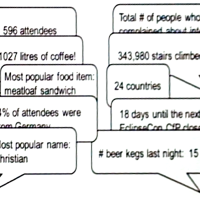Last weeks EclipseCon Europe in Ludwigsburg, Germany was great! Thanks to all those active contributors, who made this event possible. Additional to the usual Java and Eclipse topics, there were very interesting sessions on the Internet of Things, web technologies, and OSGi.
It all started on Monday with a meeting by the Eclipse Science Working Group where things revolved around representations of scientific data and their visualisation. Key projects were the Eclipse Integrated Computational Environment (parallel visualisation), DAWNSci (data analysis), OpenChrom (chromatography), and OpenFlow (geology visualisation).
The main conference began on Tuesday with a workshop on automated GUI testing based on Jubula. My personal highlights of the conference sessions on the following days were
- ’10 platforms in 30 minutes’ where Jonas Helming live-coded 10 GUIs on different platforms based on EMF Forms. The paper print-out even got delivered by micro-quadrocopter! 😀
- The presentation of openHAB (home automation bus) as the center of an Eclipse based SmartHome.
- The keynote ‘Innovation Begins at Home’ by Andy Stanford-Clark who automated his home early on and created the Twittering Isle of Wight Ferries.
- Ian Craggs providing an overview of the currently available embedded implementations of MQTT and MQTT-SN which just last week were accepted as OASIS standards.
- A live demonstration of Docker providing a very flexible infrastructure for Eclipse RT applications. I recently had the chance to try out Docker and it is really amazing. If you are looking for a lightweight and highly flexible alternative to virtualization on Linux, try this!
- Last but not least, Gordon Williams‘ and Tracy Miranda‘s introduction to the Espruino JavaScript embedded platform. It consists of an ARM based micro-controller running Gordon’s open source JavaScript interpreter and a web-based IDE. When Gordon integrated Espruino with the Eclipse Orion web-IDE, he could not access the serial port because of access rights limitations of the web-browser. As a work around he turned to generally available interface of web-applications, the audio out- and input! By adding a simple circuit and an orion plugin, he was actually able to use a normal audio jack as serial interface to the microcontroller! Now this totally reminds me of the Acoustic couplers of the good old days when the nets still made hissing sounds 🙂
All in all, with the great conference food, the entertainment with Circus Eclipse and the rock-band Cool Down, and the great speakers and participants, this is an event I am already looking forward to in 2015!








